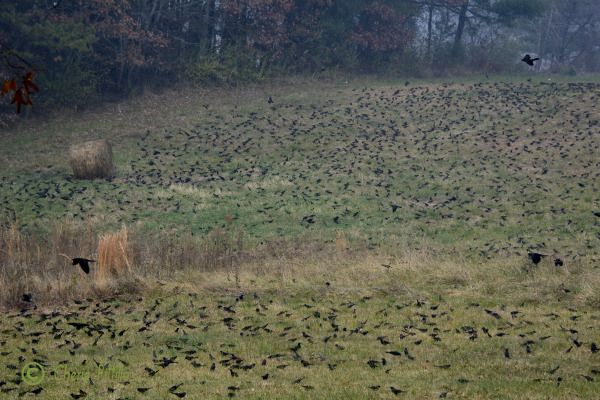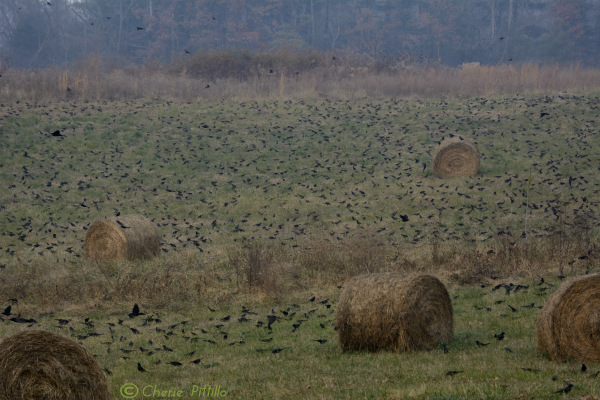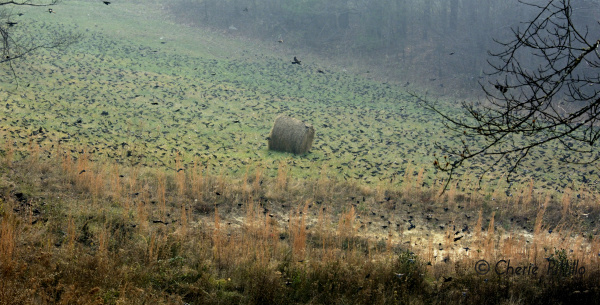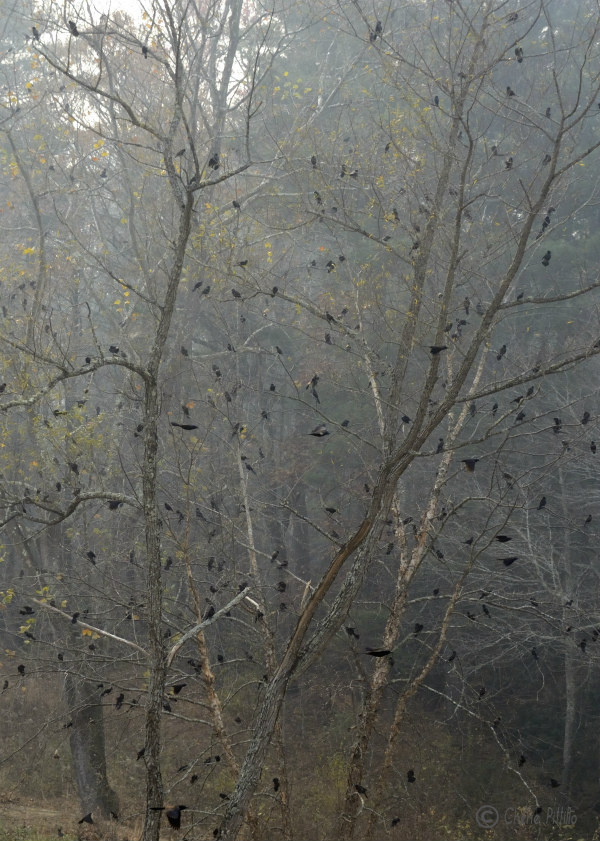While ironing, (yes, I still do that), I looked out my window to see a small mixed flock of birds including Common Grackles (Quiscalus quiscula), Red-winged Blackbirds (Agelaius phoeniceus), Brown-headed Cowbirds (Molothrus ater), and European Starlings (Sturnus vulgaris) foraging for insects, invertebrates, and seeds. I quickly grabbed my camera and slowly snuck outside.
I stood there with my mouth open mesmerized by what I observed! Everywhere I looked, thousands of birds surrounded my home. Marvelous moments followed marvelous moments as I tried to capture what I saw. I felt like I was in the circle of life. (Okay, other people would think of the Hitchcock’s film, The Birds, but not me. I did my happy dance!)
Now feast your eyes on this feathered flock at my North Carolina home. Note one photo where birds lined a small pond.
Whew!
Out of those thousands of birds, one bird, only one bird, landed in a tree close to a bird feeder. This Common Grackle, a bird seemingly-too-large-for-a-small feeder, fed on sunflower seeds.
What else did this megaflock do besides eat? They drank and bathed in a small pond, rested in trees, and preened feathers.
Without this photo, I wouldn’t have realized the numbers of Red-winged Blackbirds as the larger grackles seemed to be in the majority.
Red-winged Blackbirds are year-round residents in North Carolina and in the Yucatan. Grackles in the Yucatan are the Great-tailed Grackles not the Common Grackles I observed here. Plus transient Brown-headed Cowbirds have been recorded in the Yucatan too. Here is a link to a prior column about the Red-winged Blackbirds in the Yucatan:
By now, aren’t you wondering why these birds flock?
In late fall and winter, these mixed flocks form to travel together and seem to prefer pastures, marshes, hay fields, and grain fields. Damage to crops and winter roosts happen. Some species migrate from Canada into the US. Others may stay in their region. One winter roost probably included 15 million birds along the North Carolina border. Theories include safety in numbers help protect this mass from predators to single out an individual. Also many birds could help in finding food and sharing that information.
And then the flock departed.
Whenever I’ve seen thousands of birds or more, I am in awe of those experiences. Another one that captured my heart was the 25,000 brightly colored American Flamingos in Celestun during the winter.
MENTIONED SPECIES:
Common Grackle (Quiscalus quiscula)
Red-winged Blackbird (Agelaius phoeniceus), Tordo Sargento (Spanish), Chuleeb (Mayan)
Brown-headed Cowbird (Molothrus ater), Vaquero Cabecicafé (Spanish)
European Starling (Sturnus vulgaris)
Great-tailed Grackle Quiscalus mexicanus, Zanate Mayor (Spanish), K’awis or K’au (Mayan)
American Flamingo Phoenicopterus ruber Flamenco Americana (Spanish), Mekoh (Mayan)
JOIN YOUR FLOCK OF FRIENDS FOR A HAPPY DANCE IN APPRECIATION OF NATURE’S WONDERS!
DISCLAIMER: References do not agree on details about these species: Sal a Pajarear Yucatan Guia de Aves, A Guide to the Birds of Mexico and Northern Central America, Birds and Reserves of the Yucatan Peninsula, http://wild.enature.com/blog/why-does-the-cold-make-blackbirds-gather-in-large-flocks; http://www1.udel.edu/udaily/2012/dec/blackbirds-120711.html; http://digitalcommons.unl.edu/cgi/viewcontent.cgi?article=1014&context=vpc3; https://sora.unm.edu/sites/default/files/journals/wilson/v077n03/p0217-p0228.pdf; https://www.allaboutbirds.org/guide/Red-winged_Blackbird/lifehistory
Cherie Pittillo, “nature inspired,” photographer and author, explores nature everywhere she goes. She’s identified 56 bird species in her Merida, Yucatan backyard view. Her column, published on the 7th and 21st of each month, features anecdotes about birding in Merida, Yucatan and beyond. Contact: [email protected] All rights reserved, ©Cherie Pittillo
















1 comment
Great shots of the thousands of birds. Love the dense captures 🙂
Comments are closed.